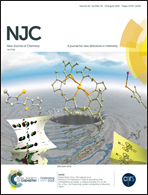Smart co-delivery of 6-mercaptopurine and methotrexate using disulphide-based PEGylated-nanogels for effective treatment of breast cancer
Abstract
Nanosized drug delivery approaches have been offered for targeting cancer cells because of their improved permeability and retention effect (EPR), enhanced bioavailability of drugs and the circulation time in the bloodstream. Besides, combination therapy has become an appealing approach for clinical cancer treatment to reach synergistic effects through reducing toxic drug side effects due to the low drug dose administration. The purpose of this study was to design biocompatible and novel multi-stimuli responsive polymeric nanogels (PEGIAn-ss-PNIPAAm-ss-PDAEMAQ NGs) for intracellular co-delivery of methotrexate (MTX) and 6-mercaptopurine (MPU) to the MCF7 cell line. The developed NGs revealed many favorable abilities including a narrow size distribution range (60 nm), high drug loading capacities (26% for MTX and 11% for MPU), and stimuli-responsive drug release. The improved efficiency of the obtained NGs was verified by MTT assay, DAPI staining, cellular uptake, and apoptosis analysis. According to the achieved results, it was concluded that the developed smart NGs have many hopeful abilities for co-delivery of MTX and MPU and can be applied in effective cancer therapy.



 Please wait while we load your content...
Please wait while we load your content...